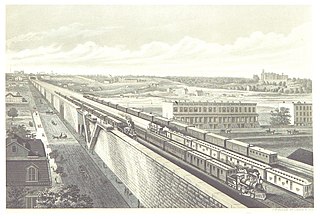Known as "The Lumber Line," the Bainbridge Northern Railway was operated by the Flint River Lumber Company and originally began operations from Bainbridge, Georgia, to Eldorendo between 1896 and 1899. It was then extended to Paulina. While principally a logging railroad, it also operated passenger service until 1908. The railroad quit operating about 1925.

The Southern Pacific Railroad of Mexico was a railroad subsidiary of the Southern Pacific Railroad in Mexico, operating from Nogales, Sonora, to Mazatlán, Sinaloa. The Sonora Railway was constructed by the Atchison, Topeka and Santa Fe Railway between 1879 and 1882. In 1898 the Santa Fe leased the Sonora Railway to the Southern Pacific in return for the latter railroad's line from Needles to Mojave, California. This arrangement continued until December 1911, when the Southern Pacific purchased both the Sonora Railway and the New Mexico and Arizona. The following June, the Sonora Railway became part of the Southern Pacific Railroad in Mexico."

The railroad history of Portland, Maine, began in 1842 with the arrival of the Portland, Saco & Portsmouth Railway (PS&P). Most of the rail activity in Portland revolved around agricultural goods bound for export and import freight from Europe. Yet Maine's largest city also enjoyed 125 years of continuous passenger rail service, from 1842 until 1967, and Amtrak began serving the city in 2001. For most of Portland's history, passenger train schedules were designed with intercity travel rather than daily commuting in mind; passenger activities were mostly confined to intercity travel from Portland to Boston, Montreal, Nova Scotia, and points west.

Wolf Point station is a train station in Wolf Point, Montana. It is a stop for the Amtrak Empire Builder line. The station, platform, and parking are owned by BNSF Railway. Prior to the formation of Amtrak, the Great Northern Railway operated passenger service along the line.

Havre station is a train station, re-fueling, and service stop for the Amtrak Empire Builder in Havre, Montana. The station, platform, and parking are owned by BNSF Railway, and the station was previously owned and operated by the Great Northern Railway

Shelby station is a station stop for the Amtrak Empire Builder line in Shelby, Montana. Near U.S. Highway 2, the station is adjacent to downtown Shelby. The station, platform, and parking are owned by BNSF Railway.
The East Carolina Railway was a short-line railroad that ran from 1898 to 1965. Originating in Tarboro, North Carolina the East Carolina Railway interchanged at Farmville, North Carolina with the original Norfolk Southern Railway.
Williford was a siding of the Seaboard Air Line Railroad in Gilchrist County, Florida, United States. It was located approximately 5 miles (8.0 km) northeast of Bell, and 2 miles (3.2 km) west of Craggs.
The Glenn Springs Railroad was a shortline railroad that operated in the South Carolina Upstate region in the late 19th century and early 20th century.

The Cincinnati, Georgetown and Portsmouth Railroad was an interurban railway serving communities in southwestern Ohio. Originally called the Cincinnati and Portsmouth, it was initially organized by Henry Brachmann in 1873.

The 110th Street station was a station located on the Metro-North Railroad's Park Avenue Viaduct in East Harlem, Manhattan, New York City. The station was built by the New York Central & Hudson River Railroad as part of an agreement with the New York City government. It was located at Park Avenue and 110th Street.

The 86th Street station is an abandoned station located in the Park Avenue Tunnel used by Metro-North Railroad for all of its trains. The station was built by the New York Central & Hudson River Railroad as part of an agreement with New York City. The station was built during the late 19th century. It was located at Park Avenue and 86th Street on the Upper East Side of Manhattan.
Ironton Junction is an unincorporated community in Coal Township, Jackson County, Ohio, United States. It is located south of Wellston and just east of Tom Corwin along Tom Corwin Road, at 39°05′47″N82°33′25″W.










